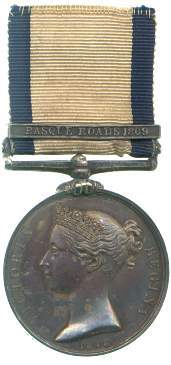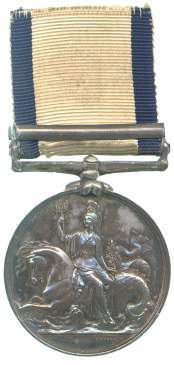Current Location: In storage
Maker(s)
Mint:
London
Ruler:
Victoria (1837-1901)
Artist:
Wyon, William
Ruler:
Victoria regina
(With the title of)
Entities
Categories
Description
Just as in 1848 the extensive land campaigns of the Napoleonic Wars and the other conflicts of the pre-Victorian era were recognised by the issue of the Military General Service Medal, those serving in the Navy at the time were recognised with the Naval General Service Medal. As with the Army equivalent and the East India Company's related award, many of the battles for which the medal was awarded had been fought so long ago that few if any claimants survived.
In addition, bars were awarded for many actions whose significance and size were, despite the heroism displayed by those involved, relatively minor. The result was that many of the bars were issued in tiny numbers, with some combinations all but unique, and the medals command a very high price among collectors because of this rarity and individuality. This in turn, along with the manufacture in most cases of more bars than were eventually issued, has led to the `improvement' of many common awards where recipients' names are shared with those present at `rarer' battles. The medal also shares with the Military General Service and Army of India Medals the oddity that Queen Victoria, whose portrait they bear, was not the ruler under whom the battles for which it was awarded were fought.
The action for which this bar was awarded was however a rather larger one, the Battle of the Basque Roads. 12 April 1809 saw a large British fleet under Lord Admiral James Gambier mount a fireship attack under one of his subordinates, Captain Thomas Cochrane, on a French fleet lying in the Basque Roads off St Nazaire, where it threatened British attempts to renew fighting in the Iberian Peninsula. The attack caused great controversy, as although Cochrane's part of the attack, involving bomb vessels, threw the French fleet into near total disarray despite their being aware of the British plan, the fireships missed their target and Gambier kept his fleet clear of the battle zone, thus meaning that Cochrane had only his own frigate to take advantage of the French panic, in which many of their ships ran aground. In later years Cochrane challenged Gambier over his diffidence in attack, and Gambier was exonerated by court martial leading to Cochrane's removal from the Navy. A balanced account of the true course of the battle is difficult to extract, but it is worth noting that Napoleon himself said of the attack, "Lord Cochrane could not only have destroyed [the French ships], but he might and would have taken them out had your Admiral supported him as he ought to have done" (B. E. O'Meara, Napoleon in Exile, or, A Voice from St Helena: the opinions and reflections of Napoleon on the most important events of his life and government in his own words (London 1821)).
This medal was awarded to Private John Halpin, of the contingent of Royal Marines serving aboard HMS Donegal, a 74-gun first-rate which had previously been the French ship Hoche. Her name under the Red Ensign came from her capture off the eponymous seaboard by British forces in 1798 while she attempted to carry Wolfe Tone, the so-called 'father of Irish nationalism' to his people to aid the French-backed rebellion in the south of Ireland. Few ships can have been involved on so many sides of a war in so short a time.
Lester Watson purchased this medal at some point before 1928; it had previously belonged to Greg, who obtained it in 1887.
Notes
History note: Gift of L. Hoyt Watson; ex Lester Watson Collection, bt before 1928. Ex Greg, 1887.
Legal notes
Given by Lester Watson through Cambridge in America, 2009
Measurements and weight
Diameter: 36.1 mm
Weight: 35.83 g
Acquisition and important dates
Method of acquisition: Given
(2009)
by
Watson, Lester
Dating
1849
-
1851
Materials used in production
Silver
Techniques used in production
Struck
Inscription or legends present
Inscription present: Bust of Victoria facing left
- Text: VICTORIA REGINA
- Location: Obverse
- Type: Design
Inscription present: Britannia with trident seated sideways on seahorse
- Location: Reverse
- Type: Design
References and bibliographic entries
Identification numbers
Accession number: CM.1371-2009
Primary reference Number: 141465
Watson Catalogue: 278
Ordering: M-0254
Previous object number: LW.0254
Stable URI
Audit data
Created: Saturday 6 August 2011
Updated: Monday 25 March 2024
Last processed: Wednesday 14 May 2025
Associated departments & institutions
Owner or interested party:
The Fitzwilliam Museum
Associated department:
Coins and Medals





